CERC news
< Previous123456789101112131415161718192021Next >
27 Sep 2021Summer 2021 editions of ADMS Model Newsletters now available
Catch up on ADMS model news in the Summer 2021 editions of ADMS 5 & ADMS-Screen News and ADMS-Urban & ADMS-Roads News which are now available. The newsletters include the latest news about the ADMS models, the annual User Group Meetings, CERC activities, training courses and recently published papers as well as a page of useful modelling tips. Previous editions of the newsletters are available here.
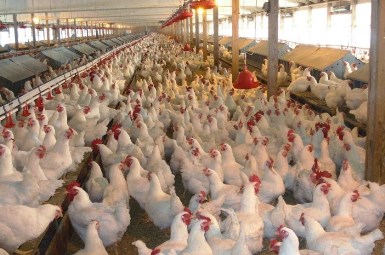

17 Sep 2021New review of odour emissions modelling with model intercomparison
Dispersion modelling plays an important role in the assessment of potential odour annoyance for planned activities and the investigation of complaints related to existing facilities. However, compared to general air pollution modelling there are particular challenges associated with modelling odour dispersion and exposure due to the importance of odour variations over short timescales to the perceived nuisance.
CERC's consultancy team, with Estonian, Latvian and Lithuanian Environment (ELLE) has carried out a Review of Approaches to Dispersion Modelling of Odour Emissions and Intercomparison of Models and Odour Nuisance Assessment Criteria. This review covers the technical approaches used for a variety of dispersion modelling methodologies applied to the assessment of odour nuisance, and summarises a wide range of odour assessment methods and criteria from different countries.
CERC's ADMS was used alongside AERMOD and AUSTAL2000 in a model intercomparison with four measurement datasets including: field odour inspections; field and wind tunnel tracer experiments; and continuous odour monitoring. Different odour criteria were compared, with a particular focus on the 98th percentile of hourly average concentrations and approaches involving concentration fluctuations and odour hours. Further discussion considers the effects of dose-response, suitable values of peak-to-mean concentration ratios, statistical methods and fluctuation models for predicting short-term odour impacts.
The work was funded by the UK Atmospheric Dispersion Modelling Liaison Committee (ADMLC) and the report is freely available here. CERC have previously led or contributed to ADMLC studies of near-field dispersion, non-point source dispersion, dispersion model sensitivity to source term parameters and urban dispersion. The reports for these studies and those by other authors on topics including dense gas dispersion and the ingress of external contaminants into buildings remain freely available.
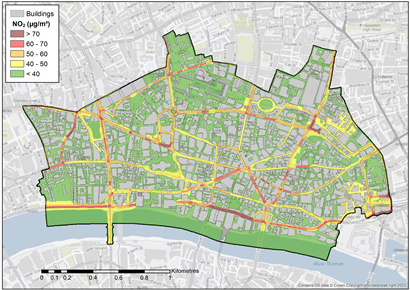
19 Aug 2021CERC evaluates City of London Corporation's progress on Air Quality Strategy
The City of London has been designated as an Air Quality Management Area (AQMA) so the Corporation is required to submit an Annual Air Quality Status Report outlining progress towards their Air Quality Strategy aims. One aim is that nitrogen dioxide should meet health-based Limit Values and WHO Guidelines in over 90% of the Square Mile by 2025. In order to evaluate progress, CERC consultants carried out an assessment of nitrogen dioxide concentrations in the City in 2019. This was done by means of a combination of high-resolution modelling using ADMS-Urban, with input data taken from the London Atmospheric Emissions Inventory and local traffic counts, and measurements from the City's network of continuous and diffusion-tube monitors. The resulting 1-metre resolution map of annual average NO2 concentrations CERC generated can be seen in the image (above). The area of the City meeting the NO2 limit value of 40 µg/m3, excluding the footprint of buildings, was calculated to be 67%, an increase from 30% in 2018. This assessment is being used by the City to help inform the public and policy-makers on progress towards the target of 90% compliance.
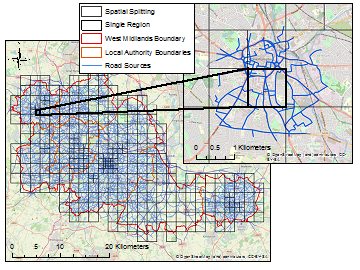
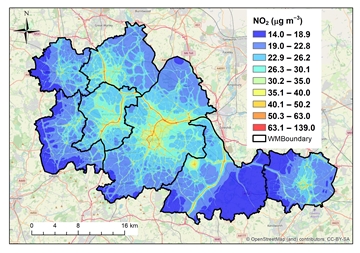
4 Aug 2021Faster results using spatial splitting: modelling the West Midlands with ADMS-Urban
The spatial splitting option introduced in ADMS-Urban version 5.0 has been used to speed up run times for modelling of the UK West Midlands region. Both turnaround time and total CPU time for modelling large regions with ADMS-Urban can be significantly reduced by judicious use of spatial splitting in combination with task farming.
The effect on run time and computational expense when using spatial splitting over increasing numbers of cores is investigated in a newly published paper co-authored by CERC researchers, and shows substantial reductions in both metrics compared to a single processor run. The reduced run times allowed the production of high-resolution contour plots and averages over different spatial areas and temporal subsets, which may be relevant for exposure and population health calculations and can be repeated for multiple emissions scenarios. Validation statistics and plots generated using the Model Evaluation Toolkit are also presented for key regulated pollutants.
This work is part of the Natural Environment Research Council (NERC) funded WM-Air (West Midlands Air Quality Improvement Programme) project led by the University of Birmingham, which aims to improve understanding of pollution sources and levels in the West Midlands region, alongside the development of tools for assessing the air quality, health and economic impacts of potential policy measures. CERC were involved in emissions processing using the Emissions Inventory Toolkit (EMIT) and also supported model evaluation for this project. The images show the variable-sized spatial splitting domains used to optimise run time, with smaller domains used in areas with a higher density of explicitly modelled road sources, and the resulting high-resolution contour plot of the annual average NO2 concentrations across the region.
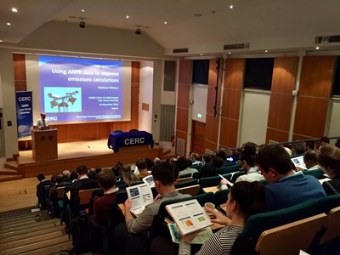
28 Jul 2021Registration is now open for the ADMS User Group Meetings, 24-25 November 2021, Online
The annual ADMS User Group Meetings are a great opportunity to hear the latest ADMS model news and advice from CERC consultants and model developers and to hear talks by model users about their own applications of the software. Normally held as two one-day meetings, with one day for ADMS 5 users and one day for ADMS-Urban & ADMS-Roads users, this year due to the COVID-19 pandemic we are holding a two-day meeting online for all users of ADMS software.
Tickets are available to order through Eventbrite until 23:30 on Sunday 21st November and cover the full two-day event. Organisations with a valid software support contract are entitled to one or more tickets free of charge depending on the type of licence held. Meeting connection details will be sent to registered participants before the event. The draft programme will be published soon.
You can also follow CERC news on Facebook, Twitter, LinkedIn and by RSS.
< Previous123456789101112131415161718192021Next >

